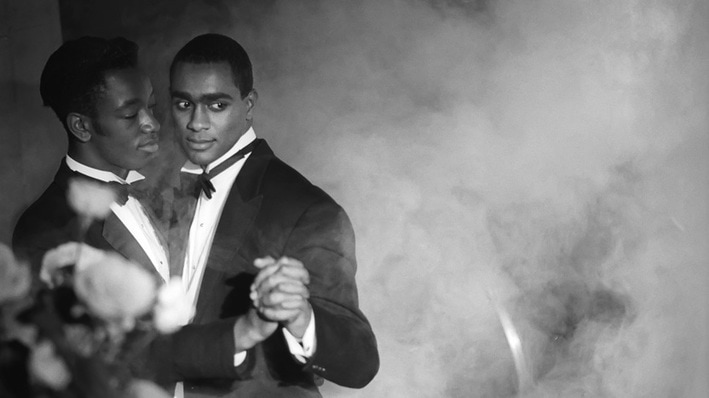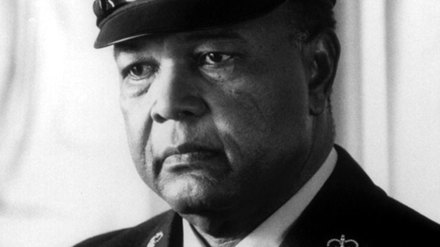Earlier this week I delivered the following introductory remarks to Frameline's retrospective screening of Looking for Langston by Isaac Julien. I thought I'd share them here.

When Moonlight won the Oscar for best picture this year, it occurred to us on the programming team that it was an extraordinary breakthrough for LGBT film…but also that this film did not emerge fully blown, out of a vacuum. It is a direct descendant of a long line of fierce and poetic depictions of black queer lives, running back through artists like Patrik-Ian Polk, Cheryl Dunye and Marlon Riggs, to the filmmaker whose work we will see today. To help us and our audiences take some measure of the progress and current state of art-making for LGBTQ filmmakers of color, we’ve put together a special multi-film program called “Barriers and Breakthroughs: Illuminating Filmmakers of Color Before and Beyond Moonlight” – 14 films and 2 panels that together help paint a picture of the past achievements and current opportunities and challenges facing artists working across multiple racial and sexual identities.
We kick things off today by going to the source: what is arguably the first black queer film by a black queer filmmaker: Isaac Julien’s Looking for Langston, today presented in a beautiful new digitally restored format.
Isaac Julien, who received the 2002 Frameline Award for his pioneering filmmaking, is a hard-to-categorize British visual artist: filmmaker, installation artist, video poet, trickster, who often addresses the intersections of histories, migrations, identities, and sexualities in his visual assemblages. Queen Elizabeth herself seems wise to his talents: just this week she used her annual Birthday Honours to name him a Commander of the British Empire – pretty heady stuff for the son of Caribbean immigrants from the island of St. Lucia, who grew up in the gritty East End of London quite far removed from Europe’s high-art circles.
His breakout film in 1989 is the work we are going to see today, Looking for Langston, a meditation on the Harlem Renaissance, the poet Langston Hughes, and both the legacy and the future of Black queer desire. Isaac had been moved and inspired on a visit to New York in 1987 to think about these matters not only because he was steeping himself in Harlem Renaissance poetry and photography—work created by artists many of whom were gay or bisexual, closeted and out—but also because his visit happened to coincide with the funeral of James Baldwin, which he witnessed with his partner Mark Nash. He returned to London and fashioned this dreamlike, theatricalized film scenario: part funeral, part club rave, part homage and part imagined love story - using images and sounds that leap across decades to create a dense intertextual pattern that is suffused with wit and passion. The passion is there from the start: the first voice you hear is that of Toni Morrison in her eulogy for James Baldwin….but the wit is right there too—as the camera floats through a stylized 1920’s funeral home, the body in the casket is none other than Isaac Julien.
The film is all about Looking—not just “Looking for” some kernels of truth about the elusive essence of Langston Hughes, but also "Looking at": the film is a luscious celebration of the black queer gaze. And you can spell that last word any way you want.
On its release, the film fought off an attempt by the Langston Hughes estate to block the use of several of the poems used in it—in fact at its first festival screening in New York, someone had to stand by the projector and push a mute button every time Hughes’ poetry was read in order for the festival to avert a court injunction. But over the years most of those wrinkles were ironed out. The layered audio track is worth paying close attention to—featuring not only Hughes’ words but the rapturous poetry of Essex Hemphill and Bruce Nugent, and wonderful period music as well as contemporary songs written by Bay Area composer Blackberri.
Today the film stands as a milestone – or more accurately the Rosetta Stone – for what queer filmmaking could be. As the film scholar B. Ruby Rich mentions in her Frameline catalog note, given the context of both the triumph of Moonlight and our current threatening political climate, this may be “the most essential film revival of 2017.”
We kick things off today by going to the source: what is arguably the first black queer film by a black queer filmmaker: Isaac Julien’s Looking for Langston, today presented in a beautiful new digitally restored format.
Isaac Julien, who received the 2002 Frameline Award for his pioneering filmmaking, is a hard-to-categorize British visual artist: filmmaker, installation artist, video poet, trickster, who often addresses the intersections of histories, migrations, identities, and sexualities in his visual assemblages. Queen Elizabeth herself seems wise to his talents: just this week she used her annual Birthday Honours to name him a Commander of the British Empire – pretty heady stuff for the son of Caribbean immigrants from the island of St. Lucia, who grew up in the gritty East End of London quite far removed from Europe’s high-art circles.
His breakout film in 1989 is the work we are going to see today, Looking for Langston, a meditation on the Harlem Renaissance, the poet Langston Hughes, and both the legacy and the future of Black queer desire. Isaac had been moved and inspired on a visit to New York in 1987 to think about these matters not only because he was steeping himself in Harlem Renaissance poetry and photography—work created by artists many of whom were gay or bisexual, closeted and out—but also because his visit happened to coincide with the funeral of James Baldwin, which he witnessed with his partner Mark Nash. He returned to London and fashioned this dreamlike, theatricalized film scenario: part funeral, part club rave, part homage and part imagined love story - using images and sounds that leap across decades to create a dense intertextual pattern that is suffused with wit and passion. The passion is there from the start: the first voice you hear is that of Toni Morrison in her eulogy for James Baldwin….but the wit is right there too—as the camera floats through a stylized 1920’s funeral home, the body in the casket is none other than Isaac Julien.
The film is all about Looking—not just “Looking for” some kernels of truth about the elusive essence of Langston Hughes, but also "Looking at": the film is a luscious celebration of the black queer gaze. And you can spell that last word any way you want.
On its release, the film fought off an attempt by the Langston Hughes estate to block the use of several of the poems used in it—in fact at its first festival screening in New York, someone had to stand by the projector and push a mute button every time Hughes’ poetry was read in order for the festival to avert a court injunction. But over the years most of those wrinkles were ironed out. The layered audio track is worth paying close attention to—featuring not only Hughes’ words but the rapturous poetry of Essex Hemphill and Bruce Nugent, and wonderful period music as well as contemporary songs written by Bay Area composer Blackberri.
Today the film stands as a milestone – or more accurately the Rosetta Stone – for what queer filmmaking could be. As the film scholar B. Ruby Rich mentions in her Frameline catalog note, given the context of both the triumph of Moonlight and our current threatening political climate, this may be “the most essential film revival of 2017.”

We’ll precede it with Isaac Julien’s rarely screened short film The Attendant, completed just a few years after Looking for Langston. Here the setting is also a kind of theatrical tableau – this time in a museum, where a middle-aged Black gallery guard locks eyes with a beautiful white boy—played, by the way, by John Wilson, who also appears as a fetching object of desire in Looking for Langston. This loaded moment in the museum sets off a witty sequence of erotic and symbolic encounters that manage to reference everything from the history of British slavery to Tom of Finland. Writing in the New York Times, Holland Cotter observed that “the film presents a complex sexual and racial dynamic of dominance and submission and a poignant sense of loss, which serves as a reminder that the piece, [like Looking for Langston,] was made at the height of the AIDS epidemic.“
We are really grateful to Isaac Julien and his gallery team in London for making these films available, as well as to Brian Freeman for first suggesting this timely program. Isaac is traveling to South Africa and not able to be here, but noted in an email to me that it was a special honor to bring these films to Frameline, since even though they have appeared in San Francisco before, they have actually never played here officially as part of the Frameline festival – and have never been seen at all in these digital restorations.
We are really grateful to Isaac Julien and his gallery team in London for making these films available, as well as to Brian Freeman for first suggesting this timely program. Isaac is traveling to South Africa and not able to be here, but noted in an email to me that it was a special honor to bring these films to Frameline, since even though they have appeared in San Francisco before, they have actually never played here officially as part of the Frameline festival – and have never been seen at all in these digital restorations.
 RSS Feed
RSS Feed
